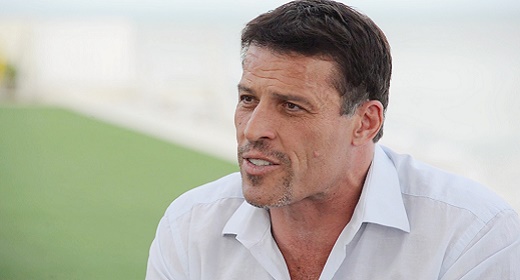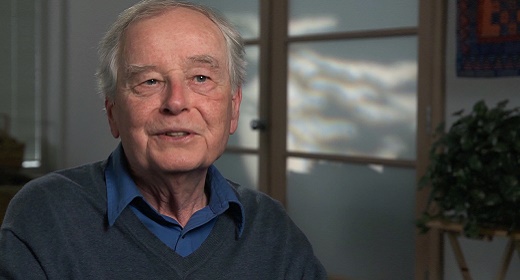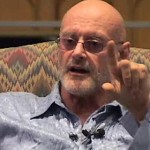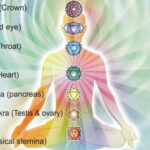A lecture by Kevin Langdon, March 20, 1992. In the Fourth Way, one works on the mind, the body, and the feelings simultaneously.
 We’ll be speaking together about the work and teaching of a man who’s widely regarded as the greatest spiritual teacher of the twentieth century. Of course, there are lots of people who have other opinions, but, among those who are knowledgeable about such things, he’s considered a very potent teacher.
We’ll be speaking together about the work and teaching of a man who’s widely regarded as the greatest spiritual teacher of the twentieth century. Of course, there are lots of people who have other opinions, but, among those who are knowledgeable about such things, he’s considered a very potent teacher.
Gurdjieff was born–though there’s some dispute about the exact date–within a few years one way or the other of 1872. He died in 1949, after working with pupils, first in Russia and later in Turkey, Germany, and France, where he established his headquarters, and also with pupils from England and America; he made several trips to this country.
I don’t want to say a lot about Gurdjieff the man, but a certain amount is indispensable. From a very early age, he was not just interested but electrified and passionately moved by certain questions that arose in him as a result of living in an area, between the Black and Caspian seas, where there had been migrations of peoples for thousands of years. As a result, there was a tremendous variety of people representing many spiritual traditions in the late 1800’s. In addition to various kinds of Christians and Buddhists and Sufis and all the more familiar groups, there were also Zoroastrians and people who practiced all sorts of things, Eastern and Western, and Gurdjieff recognized from an early age that all these people were saying different things.
He was interested in the different traditions, in reconciling science and religion, and he also saw a number of things that he couldn’t explain, at a very early age. For example, the Yezidis (who were widely regarded as devil-worshippers, though this may be somewhat of a misunderstanding of their tradition) were viewed as very strange people by those around them. One of the things that was strange about the Yezidis was that if you draw a complete circle around them they can’t get out of it. Gurdjieff saw that a young Yezidi boy, even with other boys trying to pull him out, couldn’t get out of a circle.
This is just an example of one type of strange thing that he saw. But what happened for him is that these mysteries that abounded where he grew up brought, for him, a very great fire, a questioning, and that questioning led him to the conviction that ancient objective knowledge had been preserved in various places, mainly in the Middle East and Central Asia. Starting when he was still a boy, he organized expeditions to various inaccessible places, searching for knowledge, for where the great knowledge that he was convinced had existed in various times and places had been preserved.
He was not alone. There was a group of people who worked with him. They went on expeditions together, they studied ancient books, and they tried to reason together about the ideas that interested them. It was a collective endeavor, this search for places where ancient knowledge had been kept alive. According to Gurdjieff’s own account, he actually found a number of such places, particularly a certain monastery, where he was initiated into a traditional line of knowledge that had been quite unknown, not only in the West but even in the East. There were no books or articles about it. It was quite hidden. After studying at these places, of which we know only what Gurdjieff told us (mainly in his book Meetings with Remarkable Men), for a number of years, he began teaching in Moscow what had been up until then an unknown line of esoteric transmission.
The word esoteric means something very specific and definite. It would be worth a digression to look at that a little bit. Every religion, as we see religions around us–the Catholic Church and other Christian churches, all of the formal religious bodies–are really the dead husk of something. The teaching of Jesus was alive. The teaching of Buddha was alive. Many great teachers have brought an understanding that was sufficiently powerful to assist people to become free innerly. But the teachers all die. After they die, someone else continues what is supposed to be the same tradition, but before long, in fact, according to Gurdjieff, usually by the third generation, all the real essence of the teaching has been lost and what’s being passed on are dogmas, rituals, bits and pieces of knowledge transmitted without understanding. People who don’t know try to teach others who also don’t know. The esoteric side of any religious tradition is the side where the original tradition is preserved in a pure form–one might say undergound–by small circles working with a teacher who has the requisite understanding. Gurdjieff had a great deal to say about schools, places where teachings are handed on, and we’ll come back around to that.
At any rate, having been in these remote and inaccessible places, Gurdjieff established a school of his own, working with pupils from 1912 until his death in 1949. Over that time, there were many hundreds of people who worked with him and some of those people have continued his work to the present day.
I don’t want to lecture for a long time without involving all of you, so I think before I go on and say more, let’s stop and see if there are any questions at this point.
Q.: You mentioned that there tends to be a pulling away from the actual esoteric teaching; it gets further and further away from the plan of the original teacher. Do you think that Ouspensky and Orage are very close to Gurdjieff’s original teaching?
KL: I think so. Both Ouspensky and Orage were, first of all, direct pupils, secondly, reached a fairly high level of understanding, and, thirdly, were able to produce written works that have been very helpful to people trying to come to an understanding of these ideas. It’s true that both of them left Gurdjieff, at a certain point, but this is true of many other pupils. He rather deliberately made it hot for people after a certain point, because he didn’t want them to just stay and be dependent on him. Not everyone, but most of his early pupils eventually left his direct presence and some of them worked separately. Quite a number of them established groups that, later on, came together. For example, the Ouspensky groups, at this date, are no longer separate from the Gurdjieff groups, for the most part.
There are also people who have tried to teach these ideas in their own way, without any connection–people, even, who have never been to any school, any place where they were taught by anyone who had received transmission directly–so there’s a kind of caution that’s needed in approaching anyone who claims to be a teacher in this, or for that matter, any other line. One should be very skeptical, because it’s an absolute certainty that there are lots of chartatans out there.
Q.: I believe you already covered this, but could you briefly state what the Gurdjieff Work is? It’s not a religion, is it? It doesn’t believe in a supreme being or God?
KL: This is something that we’re going to be getting into, so, instead of trying to answer a very big question like that all at once, let me defer that and we’ll come back to it.
Q.: When did he live?
KL: As I said, there’s an uncertainty about the date of his birth. According to the various informed guesses that I’ve seen, it was within six years of 1872, but probably in the 1860’s, and he died in 1949.
Q.: Was that in France?
KL: Yes, he was in Paris from the early 20’s. When he began his work in Moscow (and in St. Petersburg very shortly), things were going rather well, and then they had a little thing called the Russian revolution. It was necessary for Gurdjieff and many of his pupils to leave Russia in a hurry. Many of them were from a stratum of society that was rather too closely associated with the Czar, and it in any case conditions had become very bad, very difficult, for anyone in Russia at that time. So Gurdjieff escaped with a small group of followers and established the center of his activities next in Constantinople, following which there was a brief period in Berlin, and finally he settled just outside of Paris, at the Chateau de Prieure at Fontainebleau, and he worked with pupils there very intensively for the next few years. That period was cut short by an automobile accident which was very severe; it nearly killed him. Later on, he worked in Paris itself, with, at any given time, a fairly small circle of pupils.
Q.: Who was funding him?
KL: That’s a very interesting question. There were certainly people interested in his work who provided funds. One of the most well-known was the viscountess Rothermere. She was one of his important patronesses. But also Gurdjieff was constantly engaged in business of all kinds. Some of his business ventures were widely known, like his dealing in carpets, but he did quite a number of other things. There’s a very interesting description of all this contained in the back of his book Meetings with Remarkable Men, under the title “The Material Question.” In answer to what seemed a rather indiscrete question at a certain meeting, he gave a long narrative about his various ways of earning money, starting as a boy. In the course of this narrative, he said some very interesting things about money, its place in life, and our attitude toward it.
Maybe I could move on a little bit to the teaching itself. This is really the heart of the matter, of course. First of all, it should be said that these ideas, the ideas that Gurdjieff brought, are intended for people who are dissatisfied with themselves, people who realize that there’s something not right as they are, and who therefore have a strong wish for change. They’re are not theoretical ideas, they’re not like the usual Western scientific mold, where you seek knowledge for its own sake and figure out what to do with it later. These ideas have to do with certain possibilities which, according to Gurdjieff, it’s possible for human beings to realize. So one thing that we need to begin with is Gurdjieff’s view of human nature, which is very much at variance with the usual views, in his time and now. In particular, Gurdjieff taught that the picture that human beings have of who they are, or even what kind of being they are, is quite wrong, and certain properties that people assume they already possess can only be attained as a result of prolonged and difficult inner work.
Q.: How do you prove such a proposition?
KL: We’re coming to that. But first we have to know what the proposition is, and the things that Gurdjieff said we think we have but don’t have include continuous consciousness, unity of our parts, and the ability to do, to set out to do something and actually be able to bring it to pass. Gurdjieff said that all of these are things that man does not possess as he is, that not only does he not suspect that these things are missing in him, but he’s firmly convinced that he possesses them, so there’s a kind of illusion that people live under about who they are and what their possibilities are. Of course, if people believe that they’re awake all the time, that they’re going through life doing as they please, and that they’re able to have whatever they want, they have nothing to approach these ideas with, but for those who have understood that what they find in themselves doesn’t quite add up and isn’t quite sufficient to provide a satisfying life there may be an interest in pursuing ideas of this sort. I say “of this sort” because all the great traditions have to do with the possibility of man’s liberation, whether it’s Christianity or Buddhism or Islam or whatever. Of course, that’s not to say that everyone who calls himself a Christian or a Buddhist or Islam or something is following the real teaching. It may be a totally exoteric, totally external, imitation teaching, and because of that the person who’s following the teaching may come to no particular insights. There are lots of people who go to church on Sundays who are not even really interested in themselves. It’s all external.
The first response to this question about how we know all that has to come through our direct observation of ourselves. Anything that somebody else tells us is not good enough. One experiment that Gurdjieff suggests is to take a watch with a sweep second hand and to try to be conscious of oneself, here and now, while watching the second hand go around. People are very surprised when they find out what a short time they can do this. Often even a few seconds is impossible, but certainly it’s a maximum of just a few minutes before one finds that one loses one’s attention. Something else comes along and my attention is swallowed up. That’s a really important phenomenon that Gurdjieff gave a central place in his teaching, the phenomenon of identification. One takes oneself to be the part that happens to be active in the moment. So here I am at the dinner table and cake is served and I’m the cake-eater. Here I am talking with a friend I want to impress and here I am, the witty one. Here I am driving along in my automobile and somebody gives me the finger and I’m the angry one. And it’s very difficult to really grasp what a tremendous thing this is in human life, this tendency to identify with everything, that is, to take the part of oneself that’s specialized for dealing with a particular area, particular subject matter, and in the moment when I’m dealing with that to take that for myself; the rest of the universe, even the rest of me, doesn’t exist during that state of identification, and what makes that possible is that we can do many things involving our functions, moving or having emotions or thinking, without any consciousness at all, simply automatically, and we don’t notice it because our automatic processes are feeding us the right context. I may have been completely asleep for the past ten minutes, not have attended to what’s in front of me at all, and yet, through the unconscious process of thought, certain cues are there; if somebody refers to something that was said five minutes ago, I can tune in and pick up and it’s as if I’ve been there all along, but I haven’t, and that makes all the difference in the world, because when I’m asleep in this sense, without consciousness of myself, without awareness that I am, here and now, what goes on in me can hardly be called life, because I don’t live it, I’m not there. So if this begins to seem like a description of me, as opposed to an abstraction, that could be the beginning of some very serious concern, because not only do people live in sleep, but they can live in sleep their whole lives, they can die without having woken up.
A little child is born. In a certain sense, he’s quite pure. He is what he is. When an infant cries, there’s no calculation involved (I’m not talking about a five-year-old). He is much closer to the reality of himself, but he doesn’t have accumulated knowledge, sophistication, experience, and, particularly once he begins to learn language, the people around him have a rather strong vested interest in not being told that the emperor is naked, and so, from a very early age, children are taught not to see that the emperor is naked, and, after a while, that works. They begin to take on the characteristic neuroses of the people around them.
Q.: What do you mean by “characteristic neuroses”?
KL: They begin to take on this illusory sense of “I” connected with the part of themselves that identifies with one thing or another. They begin to believe certain false propositions, like that you can do anything you want to. This is believed by millions with no evidence at all. Still worse–and you see this particularly in certain types of drama on TV, like soap operas–when somebody is facing a crisis–a woman’s husband dies or something–and her friend says, “You’ve got to believe that things are going to be all right,” encouraging her not to be in front of the truth. That just permeates our culture, and our culture has become, for better or worse, the world culture (for example, the Japanese are more American than the Americans). There are pockets here and there where more traditional forms of culture still exist, but they’re disappearing very rapidly, so in a sense the whole world is Western.
In the world we live in there is this process of conditioning that goes on from an early age which rapidly makes a young person into yet another believer in this whole set of illusions that we’re speaking about. From a certain point of view, it can be said that human behavior consists of habits and reflexes. Everything that is not a reflexive result of the hard-wired neurological machinery is a matter of habits learned from childhood to the present, and if people were to see that they would experience horror at their condition, but, for the most part, people don’t see it.
When you catch a glimpse of your real position–and this is very possible for anyone who’s begun to listen to these ideas, because the ideas have an action, a power, that can open one to seeing new and unexpected things–you see that you’re not who you thought you were–in a very real sense you’re not anybody, because you’re not awake, you’re not unified, you can’t do as you want to–and that leads to a wish to be different, the arising of the wish in yourself to have these qualities that you once thought you possessed but that you see that you don’t.
The experience of wishing to have something more is very familiar to me, from a very early age. I was fortunate in that I saw that there was something really important missing in me at quite an early age; certainly by the age of seven or eight this question had come up.
If the wish is there and I feel connected with it, there begins to be a movement–or there can be–toward defining to oneself what one wishes for. One can define an aim for oneself and this turns out to be very valuable. A man who has an aim understands, to a certain extent, what he wishes for, where he wants to go, and can make choices based on that. This becomes particularly important if he comes into contact with the possibility of connection with a school.
Even with an aim, there’s one problem that turns out to be very important, and that is that, because one constantly forgets oneself, the direct awareness of one’s own existence in the moment, here and now, one also forgets one’s aim. One moment I have an aim; the next moment I’m caught by something, a particularly interesting conversation, or a grievance that I have, or any of the other things that preoccupy my mind.
Certainly it should be familiar to all of us that there are times when, regardless of what you may have set yourself to do, to just work at your job today, or complete a project of your own, or whatever you decide to do, it’s just totally commonplace that you find yourself diverted, distracted by something, so if any progress at all is to be made it has to be made by continually coming back, beginning again, picking up the attention and starting again to work at it, to move in the direction one wants to go, but in order for that to be possible one has to admit to oneself that one’s lost the connection. Sometimes that’s not too hard. Sometimes I come to myself and I realize that I’ve just spaced out on what I intended to do. Other times it’s difficult because I think that I’m continuing in the direction I started in, but, without my noticing it, the direction has changed; I’m going in quite a different direction. This is connected with one of the great laws Gurdjieff spoke about, the Law of Seven, which we’ll come to in a bit.
Given these handicaps that we all face, one might ask, “What is possible; what can be done?” One can’t set out to go somewhere and go there without getting lost. One can’t even be aware of oneself for very long. What is possible? What’s possible is, first of all, to make efforts to observe oneself, to see how one is, in all one’s parts, objectively, without letting one’s view of anything be colored by likes and dislikes, various bits and pieces of opinion that are carried over from one context to another without our noticing. There’s a kind of tentativeness that’s needed, a kind of discrimination.
One aspect of what I inevitably see when I look at myself is my tendency to identify at every moment, and if I’m quick enough I can see the identification begin to arise and beckon to me: “Come, get identified with this; become the angry driver, become the chocolate cake eater, become this artificial identity.” And, right in the moment, it’s possible to decline that invitation and turn back toward myself, remember myself, and to remember myself is to include more of myself, of what is encompassed by my attention right in this moment.
What Gurdjieff called work has to with certain inner efforts, efforts to study oneself as one is and to be present to oneself in the moment. If one is able to do that successfully, the state called self-remembering is the result. When a man remembers himself, he has a certain amount of freedom. When he doesn’t remember himself, he’s just a piece of meat.
It’s very difficult to accept the necessity of following this method, because people always want to do something about whatever is wrong, and this teaching tells us that we can’t do anything. What’s possible is this effort of self-remembering in the moment. I don’t change anything; I just witness it. As a result of that, over a period of time, there’s a reorganization inside. Part of it is not mysterious. Part of it has to do with acquiring knowledge. As one comes to know oneself better, that knowledge is taken into account in all one’s plans, all one’s decisions. Part of it is not so simple; part of it is a mystery–and, indeed, if what we’re speaking about here is a kind of knowledge, then, to those who don’t have that knowledge, it’s mysterious. There’s something very mysterious about calculus, too, if you don’t know calculus. There’s a very great deal involved here. The study of man, according to this or any traditional teaching, is an enormous subject. Certain traditions have been better at preserving writings than others. For example, in the Buddhist canon, even just in the Tibetan Buddhist canon, there are thousands of volumes containing knowledge that people who have been working in the way we’re talking about here have written down for the benefit of others who follow after them. You see this in all the traditions, to varying extents. There’s certainly quite a library of Christian mystical and monastic writings that are very much on the issues that come up in this kind of work, which are really quite similar in different traditions.
Q.: Outside a unified set of reactions to events or whatever happens, are you sure there’s anything else?
KL: How do you mean, unified?
Q.: Well, I do think I react in a specific way to many things. I have a consistent reaction, politically, socially, to the events of the day when I work with children.
KL: Do you mean that you react consistently to similar stimuli?
Q.: I think each of us is fairly consistent in our patterns of stimulus-response. Response to all events that are occurring. I’m not aware of being something separate from the events I’m dealing with.
KL: You’re giving a very good description of the state of identification.
Q.: Are you saying that there is a consistent self that is there somehow?
Another questioner: Excuse me, what I hear is that you’re confusing two meanings of “consistent.” What I think you’re trying to say is that you habitually react in the same way…
First questioner: No, I’m not even saying that. That’s too tight. But, according to Gurdjieff, there is somebody separate from the responses?
KL: There’s the potential of an I which is separate from the responses.
Q.: Where does it come from?
KL: It comes from the whole.
Q.: You mean, in the Jungian sense that we are all joined?
KL: No. I mean the whole of oneself. You know the idea of emergent levels?
Q.: No.
KL: Certain phenomena don’t appear until you have a critical mass of something. For example, if you have a single drop of water, that drop has certain properties, but there are other properties you don’t see until you have a whole glass of water–circulating currents and so on. They may be there, but certain things appear when there’s enough of something to make them visible. When the human machine is functioning in this fragmented, compartmentalized way, there are certain emergent properties that one doesn’t see. There’s a kind of conscious attention to oneself that causes one to be able to include more of the parts in one’s attention simultaneously in the moment. It’s that possibility–of going in that direction–that we’re speaking about.
Q.: I think it would be useful at this juncture to explain the difference between the persona, the realm of the personality, and the essence, and not to confuse essence with the great I.
KL: I was just about to get into exactly these ideas. Certainly a very big place in Gurdjieff’s teaching is occupied by the idea of an essence, that we’re born with, and personality, which is what is acquired from outside oneself. According to Gurdjieff, although these two things are quite separate and quite different in their characteristics, they are mixed in us in such a way that we can’t reliably distinguish the one from the other. On the whole, personality–what is external, what is not one’s own, what is learned from the outside–is active and essence is passive in us as we are.
As a result of inner work, it’s possible for the personality to become more passive, permitting the essence to unfold and to assume its rightful place in our being. As we are, as Western man, we lead with the head, with personality, and that state of affairs is unfortunate for a number of reasons. One of them is that the head works with a slower energy than the other, in Gurdjieff’s term, centers. He spoke of seven centers: the intellectual center, the emotional center, the moving center (which has to do with voluntary movement), the instinctive center (controlling involuntary processes of the body and the senses), and in addition to those four centers, which Gurdjieff called the lower centers, the centers that are directly observable, there are three other centers. There’s the sex center, which operates with a very fine energy and enters in a big way into ordinary life but is difficult to see.
Q.: A fine energy, as opposed to a gross energy?
KL: Yes. I’ll come to that, too. There’s a cosmological side to this teaching, which I will speak about. Levels of energy has to do with that.
Gurdjieff taught that the essence, at a fairly early age, begins to close down and personality takes over, because of all this stuff that’s been inculcated by the society around one.
Q.: Could you define essence more precisely? It’s innate, you said?
KL: Yes. The body is the foundation on which essence exists. The essence includes the senses, certain inclinations that belong to oneself as opposed to having been learned from outside. For example, if somebody likes, say, rap music, that probably is not an innate thing. He’s probably been influenced by others. It’s supposed to be cool to like that.
Q.: Would you say that liking chocolate is from essence?
KL: That could be. It could be from essence, but not necessarily. It might be learned.
Q.: You’re saying that essence is everything that’s not learned.
KL: Yes.
Q.: Would you include sexual impulses, then, as part of the essence.
KL: Yes, that’s right, the sex impulses are part of essence–at their base, where it’s a pure impulse. Of course, sexuality in modern man is mainly dominated by personality. It’s very clear that this is an area of life where there are rather more abnormalities than in certain other areas. It’s very difficult. Even among very solid and stable people, relationships are terribly difficult these days. We all know that.
Q.: You were going to tell us about the seven centers of man. You talked about the lower centers and you talked about sex. What are the other two?
KL: The other two are the higher emotional center and the higher intellectual center.
Q.: How is the higher emotional center differentiated from the higher intellectual center?
KL: That’s a very good question. I think we can understand the lower centers fairly well. They contain what we call the functions in ordinary psychology. The sex center already begins to be a bit tricky, because sex energy enters into so much of life. The higher centers have to do with the possibility of higher states of consciousness. Gurdjieff spoke about four states of consciousness possible for man. The first is ordinary sleep at night. The second is what he called “waking sleep,” the state in which we walk around and write books and make love and do all sorts of things. The third state is self-consciousness, the state in which one is actually conscious of one’s own existence and fully able to see all the parts at once. And beyond that, objective consciousness is consciousness of the nature of things in themselves, but that’s very remote for us. The higher emotional center is connected with the third state and the higher intellectual center is connected with the fourth state.
Q.: You mean objective consciousness? And the third state is connected with self-consciousness?
KL: Yes.
Another questioner: The clue in this is what is utilized in the functioning of the higher intellectual and the higher emotional. It’s the difference between the myths of the higher emotional and the symbolism of the higher intellectual.
KL: What you’re referring to is very interesting. Gurdjieff said that myths are intended for the higher emotional center. They communicate on a different level than the ordinary intellectual kind of communication, or, for that matter, the ordinary emotional kind, which is full of sentimentality.
Q.: When you say centers, you don’t mean a physical place in the body?
KL: There is a physical place where the main concentration of each center is, but each center actually involves the whole body. The center of gravity of the intellectual center is in the head. The center of gravity of the emotional center is in the chest . . .
Q.: In the chest? Not the brain?
KL: . . . and the center of gravity of the moving center is in the spine.
Q.: What’s your confusion? In the cortex, there are the connections. Most recent medical investigation has realized that there are different parts of the brain which handle different things. But the connnections with these other centers–and, by the way, the centers are very much akin to the chakras in the Indian, yogic, tradition . . .
Another questioner: That’s something I don’t believe in.
First questioner: You may not wish to, but it’s a working hypothesis.
KL: It’s not necessary to believe in anything. This is just a description of how the human machine functions which is for actual verification through one’s own study of oneself.
Q.: The emotional center is in the chest?
KL: Yes.
Same questioner: It’s really very difficult for me . . .
Another questioner: But it’s connected through the central nervous system. The central nervous system runs down the spine. From the base of the spine to the center of the highest one, which is in the brain, there are physical connections, through the nervous system itself.
First questioner: There are physical connections from every nerve in your body to the brain.
KL: At any rate, we’re not talking about ideas to be believed or disbelieved. These are ideas to be studied and observed in oneself, so there’s no point in talking about whether you believe it.
Q.: But I’m not certain that my emotions are in the chest.
KL: You haven’t experienced that, but that doesn’t mean it isn’t there.
Q.: No, but you’re saying it’s there doesn’t mean it’s there.
KL: No, that doesn’t mean it’s there. We’re not saying something that’s a logical argument, so that at the end you write Q.E.D. The model is not mathematics; it’s more like physics.
Q.: Is it scientifically verifiable?
KL: Oh, yes.
Q.: That the emotional center is in the chest?
KL: Yes. The word “scientifically” has to be qualified, because there’s one big difference between investigating these things and investigating external phenomena, which is that there is no room inside my psyche for more than one scientist.
Q.: Perhaps you can tell me how I can verify that the emotional center is in my chest.
KL: Yes. First of all, in studying the centers, there is a difficulty in that we’re not really clear about what function is involved in various things that we experience, and so, at the beginning, it’s important to find clear-cut cases–and that’s certainly possible. There are times when you can see that something is a thought or an emotion or a moving impulse. There are other times when you can’t, and when you can’t, you just put that to one side. So at the beginning one could think of it as simply making a study of the functions in myself. I see a thought; I label it as a thought. I see an emotion and I say “This is an emotional state.” As one observes these things, as one registers the cases that are clear, over a period of time, things that were not clear at the beginning begin to be clear, it becomes possible to see things that one didn’t see originally. That is to say, working with the attention is like working with a muscle. The more you do it, the stronger it gets. When it gets strong enough, you may be able to see things that you not only can’t see right now, but you can’t even conceive of.
Q.: It sounds very much like what the Buddhists call “insight meditation.”
KL: Yes. There is definitely a similarity between the work of self-study that I’ve been describing and Theravadan Buddhist practice. It’s not identical. There are differences between different traditions. It’s not that one is better than another, but a certain presentation may be more accessible to people who have had a certain upbringing. Gurdjieff knew the West, as well as the East, and the way that his teaching is couched makes it more possible for Western man to assimilate it and to work with it than is the case for some other teachings.
To take an extreme case, there are people who do sitting meditation twelve hours a day. We’re not built for that, not only physically but also in our inner life, in that we’ve been filled up to the brim with associations. Someone who’s been raised in a traditional society that doesn’t get him so associatively wound up may be able to sit quietly for a long time. Western man begins to sit and after a not very long time all sorts of associations proceed in him, he loses contact with his body, his intention, and it just becomes another kind of imitative practice. So, for most Western people, a path that took as a given that we’re all going to sit twelve hours a day probably wouldn’t be very feasible, for many reasons. I can’t keep my associations quiet; my body won’t tolerate it; I can’t even want to. If I find myself in a situation where somebody’s making me sit twelve hours a day, very soon something in me will rebel and I’ll stop. Regardless of what I think, that’s what’s going to happen if I really put myself in that situation.
Q.: So sitting is not a technique of Gurdjieff’s.
KL: I didn’t say that. But we don’t do prolonged sitting, prolonged difficult physical exercises. Certain yogic practices and things that fakirs do are quite extraordinary; they do complicated physical postures coupled with mental exercises for days at a time. This way doesn’t rely on these kinds of heavy-handed methods, but the trade-off is that, in following these ideas, one has to think for oneself a great deal more than in following certain other traditional paths.
Q.: The principles that you’re talking about seem to be essentially derived from Buddhism and Hinduism. I think it’s kind of oversimplifying it to say that the only people who are following these paths are sitting twelve hours a day or walking on beds of nails or something.
KL: Not everybody on the Hindu or Buddhist path is doing something extreme like that, but I used the extreme examples to show that there are certain ways that, while they may be perfectly authentic, are not for me as I find myself to be.
Q.: But aren’t these principles essentially the same? The notion of the essence is both Hindu and Buddhist, Buddha nature and the atman.
KL: Of course. The same essential core exists in all the traditions, but the forms are different.
Q.: But not in Christianity.
KL: Oh, yes. It’s in Christianity, too.
Q.: Not that notion. There’s a notion about immortal soul and outside being, but that’s not true in either Hinduism or Buddhism, that the being is outside oneself.
KL: It’s not true in Christianity, either. The real Christianity, esoteric Christianity, has always been concerned with finding the divinity within. It’s the external form of the religion that puts everything outside oneself.
Q.: Maybe I should ask it differently. What would you say is the essential difference in the Gurdjieff view of the essence or these different levels of consciousness and how one attains them?
KL: I’m not sure that there’s a big difference in view at all, but there are differences in methods and in the order in which different things are taken up.
Q.: In relation to the idea of the Fourth Way, could you explain about the other three ways? This young lady is from India, so she understands something about the way of the fakir, the way of the yogi. The way of the monk is a little different . . .
KL: But the way of the monk is easily understandable by people in the West. Let’s go into that distinction. Gurdjieff spoke about three well-known traditional ways: the way of the fakir, which is primarily work with the body; the way of the monk, which is work with the feelings, purifying feeling (there are people who retire from ordinary, worldly life to follow this way in the West); and the way of the yogi, which is work with the mind. Now, the third one requires a little bit of explanation in this context, because the whole idea of yoga is much better known now than it was at the time Gurdjieff spoke about it in that way, and the sense in which he used the term doesn’t correspond to what’s most often referred to as yoga in the West, and certain types of “yoga” (e.g., hatha yoga) do not emphasize the mental.









































